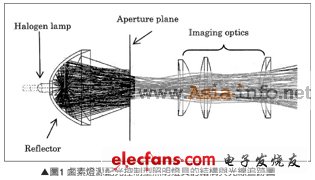Most of the traditional lighting sources use lamps and incandescent bulbs. Basic large-scale lighting fixtures emphasize the control of light distribution. When the luminous efficiency is simply considered, fluorescent lamps and high intensity discharge lamps (HID: High Intensity Discharge) are excellent, but high intensity gases The electrical dimming range of discharge lamps is very narrow. In contrast, when the optical system of a fluorescent lamp illuminates a specific area, if compared with the tungsten wire of a halogen lamp, its light-emitting part is very large, and it is impossible to efficiently converge light from the light source. In addition, large lighting fixtures require 0 ~ 100% flexible dimming. Generally, thyristors (Thyristor) are used to control the arc voltage and the driving voltage of the bulb is changed to achieve the dimming effect. Therefore, almost all light sources of large lighting fixtures use halogen lamps. . Large lighting fixtures do not require uniformly illuminating objects. Usually, multiple lighting fixtures are used to change the direction and range of illumination. Therefore, large lighting fixtures are mostly equipped with an adjustment mechanism for the illumination range. The adjustment of the illumination range is divided into: changing the bulb and the lens The interval; converge the light to the opening (Aperture), change the focal length of the lens group that projects the opening. In fact, it must be used according to the type and use of the light fixture. In recent years, the environmental protection noise of the earth has been increasing day by day, and large-scale lighting fixtures also require energy saving and reduction of carbon dioxide emissions. Therefore, foreign lighting fixture manufacturers have abandoned the traditional low-luminous efficiency incandescent bulbs and switched to high-efficiency new-generation light-emitting diode light sources. In 1990, Nichia Professor Nakamura developed high-brightness blue light-emitting diodes. In 1996, high-brightness blue light-emitting diodes combined with YAG: Yttrium Aluminium Garnet (YAG: Yttrium Aluminium Garnet) phosphor white light emitting diode lighting source came out immediately The next generation light source has become the focus of global attention. The improvement of the luminous efficiency and high power of the white light emitting diodes are used as light sources for large-scale lighting fixtures in addition to general indoor lighting. It is generally believed that the dimming characteristics of LEDs are very good, and the chromaticity change and response characteristics during dimming are more sensitive than traditional halogen lamps. However, the light-emitting diode light source for large lighting fixtures must solve the following problems: Very few; white light-emitting diodes with blue LED combined with yttrium aluminum garnet phosphor, its light distribution difference is very easy to cause color unevenness on the illuminated surface. When multiple LEDs are used, the distribution between the LEDs is very large. Then this article will take the large-scale lighting fixtures as an example to deeply discuss the optical design of high-power LED lighting fixtures. Design of LED lamps Lamp structure As shown in FIG. 1, when a halogen lamp is used to construct an optical system, an elliptical reflector is mostly used to concentrate the light to the opening for projection. In the case of light-emitting diodes, the light beam of a unit light-emitting diode is very small. When used as an illumination light source, several to dozens of light-emitting diodes must be used. Therefore, the control of light generated by a plurality of light sources is very important. When multiple LEDs are used as light distribution control lighting fixtures, high-power light-emitting diodes and optical systems must be combined to use the Array to collimate the light generated by the light-emitting diodes (Collimate), and then through the condenser lens ( Condenser Lens) Mix the light at the opening and collect the light, and finally use the imaging optical system to project the image of the opening light source at variable magnification and perform the so-called "light distribution control". In addition, the use of lens arrays and condensers can also eliminate the uneven brightness and color unevenness of the illuminated surface. Most large-scale lighting fixtures use about 1000W halogen lamps. 1000W halogen lamps are equivalent to 25,000 lumens (lm) of light beams. If the lighting fixtures using this light source are converted into the current LED capacity, the efficiency is almost impossible to achieve. Figure 2 and Figure 3 are the specific structure of the lighting fixture designed by the researchers according to the characteristics required by the above large-scale lighting fixtures. The overall structure is shown in the figure. The LED light sources are arranged in a total of 8 & 8; 64, which are packaged on a substrate that has been considered for heat dissipation. The 8 series connected circuits are driven by a constant current power supply of 35mA. In addition, based on the consideration of improving heat dissipation, an axial cooling fan is used for forced air cooling.
The LED Indicator is a device that monitors the operation or position of an electrical device with light. The indicator light is usually used to reflect the working state of the circuit (with or without electricity), the operating state (running, outage or test) of the electrical equipment, and the position status (closed or disconnected).
In our company,mainly have eight series(as follow):
AD22-22DS LED Indicator
LED Indicators,LED Indicator Light,LED Indicator Lamp,LED Indicator Bulbs Ningbo Bond Industrial Electric Co., Ltd. , https://www.bondelectro.com

AD16 LED Indicator
AD22-22MSD Buzzer
AD22-30DS LED Indicator
AD22-DAV Current Voltage Indicator
AD22-DAM Current Indicator
AD22-DVM Voltage Indicator
June 30, 2020